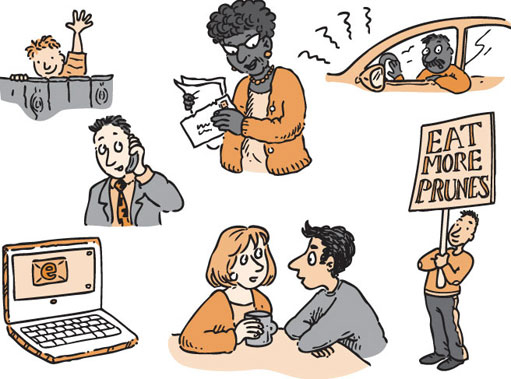4 Communication skills
You may be interested to know that the word ‘communicate’ comes from the Latin word communicare, meaning ‘to give’ or ‘to share’. So it is clear that the idea of communication has always involved more than one person – there are always those who send a message of some kind and those who receive it. Having good communication skills involves being aware of both sender and receiver.
Communication takes many forms, for example:
- talking
- listening
- body language
- tone of voice
- writing
- sharing ideas or information online.
We often change the way that we speak depending on the circumstances; most of us, for example, watch what we say so as not to offend or upset others. But the verbal or spoken aspects of communication form only a part of what is going on. Whenever someone communicates with another person, they are engaged in a constant process of interpretation to try and make sense of what is going on.
Most of us have some awareness of the impact of body language. We may believe, for example, that politicians can modify their body language so that they do not give away too many clues about themselves. We probably try to make sure that our own body language suits the particular situation we are in. For example, you would probably act differently if you were in the middle of an excited crowd compared with if you were in a public library.
Given the complexity of communication, it is not surprising that we can often get misunderstood or misinterpreted. It is perhaps surprising that so much of our communication does appear to achieve at least some success.
Communication continues most of the time while we are awake. It even seems to go on while we are asleep. When we dream, research suggests that some parts of our brain are communicating with other parts.
Human societies have developed many ways of communicating. Often, these make it possible for one person, or groups of people, to communicate with many others. These people may or may not be present when the process of communication is started. These types of communication include lectures, concerts and the media (such as television, radio, newspapers and the internet).
To summarise:
- Communication takes many different forms.
- Communication uses different channels.
- Communication affects all aspects of life.
Sometimes we feel we are communicating well, only to find that we have been misunderstood – that we haven’t really communicated at all.
It has been suggested that:
The meaning of communication is the response you get.
What do you think of this idea? Can you think of examples from your own life? It is always important to check the responses of the people you aim to communicate with. Once you have a reasonably clear picture about this, it is much easier to see where you might want to increase your communication strengths and decrease any weaknesses.

